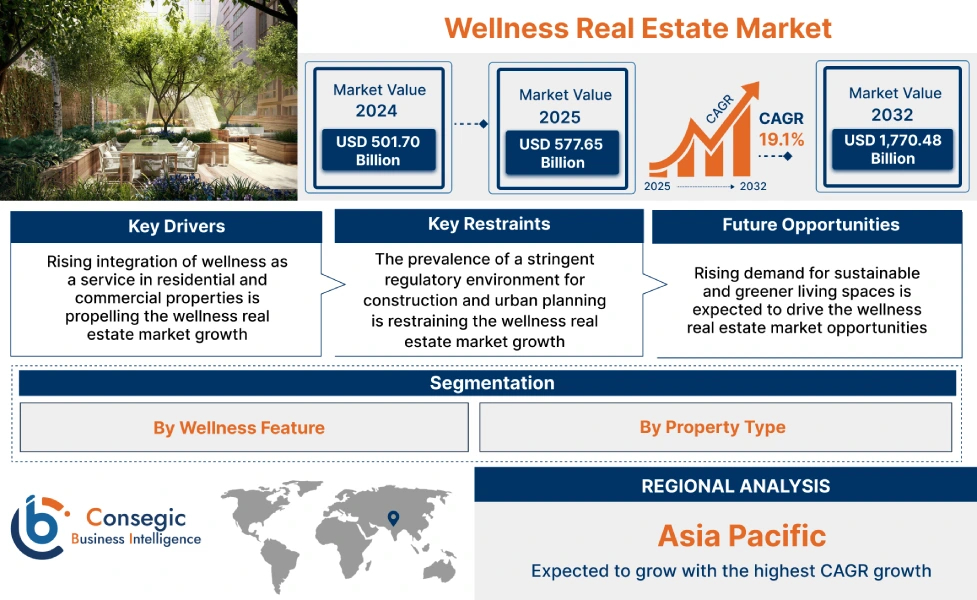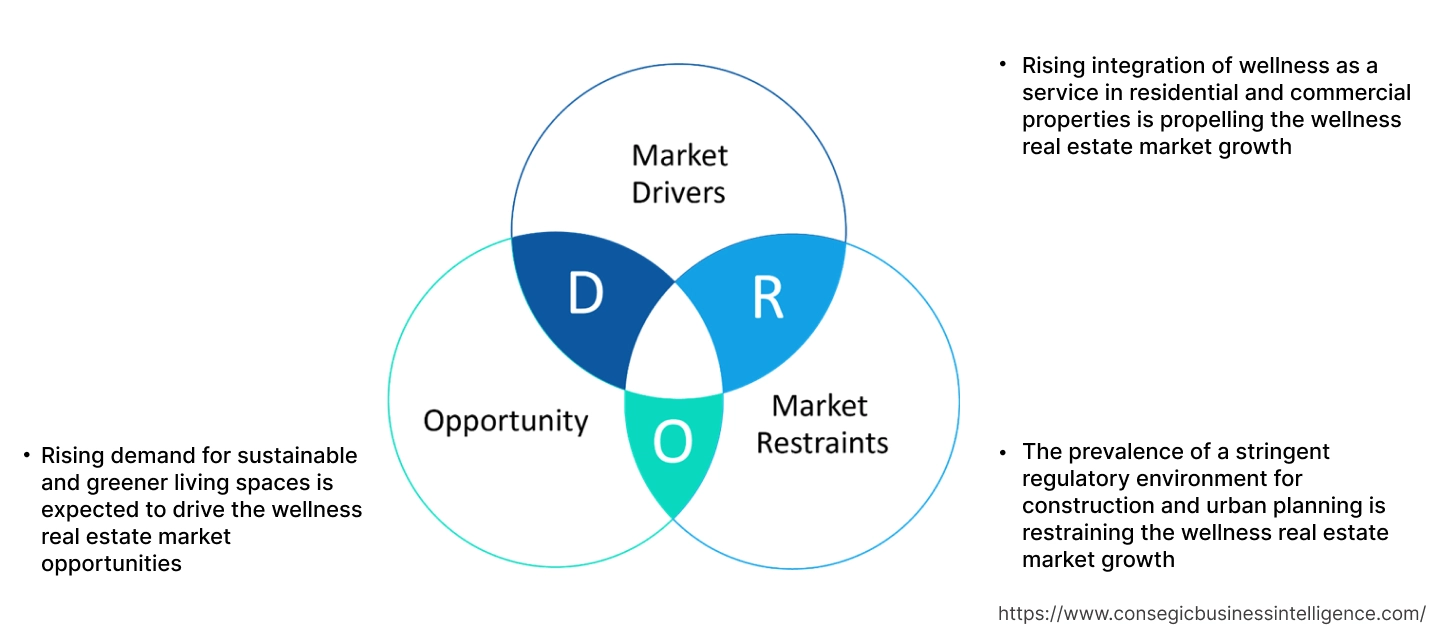Wellness Real Estate Market Size:
Wellness Real Estate Market size is estimated to reach over USD 1,770.48 Billion by 2032 from a value of USD 501.70 Billion in 2024 and is projected to grow by USD 577.65 Billion in 2025, growing at a CAGR of 19.1% from 2025 to 2032.
Wellness Real Estate Market Scope & Overview:
Wellness real estate refers to the design, construction, and operation of buildings and properties that are designed to proactively support the physical, mental, and social well-being of their residents/occupants and users. These properties usually incorporate features such as improved air and water quality, increased access to natural light, spaces for movement and relaxation, and others for promoting health and overall wellness. Moreover, wellness real estate offers a range of benefits such as physical health improvement, mental & emotional wellbeing, improved social and community connection, environmental benefits, and others.
How is AI Transforming the Wellness Real Estate Market?
AI transforms wellness real estate by enhancing sustainability through energy optimization and predictive maintenance, creating healthier and more comfortable living and working environments. Additionally, it also improves occupant well-being by personalizing spaces, using smart home features, and analyzing building health for proactive issue resolution. Further, AI drives operational efficiency for developers and managers, enabling faster transactions, improved property valuations, and a more data-driven approach to wellness-focused development.
Key Drivers:
Rising integration of wellness as a service in residential and commercial properties is propelling the wellness real estate market growth
There is an increasing emphasis on the development of projects that can facilitate community wellness, converting spaces into ecosystems that actively support the design, programming, and operations of holistic and long-term wellbeing. This usually ranges from nutrition and fitness coaching to mental health support and medical consultation services, which are available on-site or accessible through digital community platforms. Moreover, this wellness as a service trend assists in differentiating projects and improving their respective performance, along with adding project value and responding to the rising demand for wellness-oriented lifestyles. Additionally, the integration of wellness as a service in residential and commercial properties can assist in maintaining or improving social cohesion, reducing loneliness, and supporting diverse community needs in terms of physical, mental, and social well-being.
- For instance, in November 2024, Canyon Ranch, a pioneer in the wellness resort sector, created a new retreat, known as Longevity8, which focused on extending both lifespan and health span through integrative wellness principles. The retreat was inspired by eight principles, including integrative medicine, nutrition, flexibility and fitness, sleep, mental and emotional health, spiritual wellness, outdoor activity, and strength & endurance.
Hence, the rising integration of wellness as a service in residential and commercial properties is driving the wellness real estate market size.
Key Restraints:
The prevalence of a stringent regulatory environment for construction and urban planning is restraining the wellness real estate market growth
The prevalence of a stringent regulatory environment for construction and urban planning is among the key factors restraining the market. The development of wellness real estate has evolved rapidly in recent years, however, the regulations governing the construction of homes, offices, retail, and cities have not evolved much at the same time.
Construction activities are typically regulated at the local level, and in cities across the world, there are regulations that may prohibit healthier urban design and building practices. For example, there is a presence of zoning, land use, and building codes that forbid mixed-use & higher-density developments, exclusionary zoning laws which result in communities separated by age, income, and race, along with street design and parking rules that hinder walkability and encourage car-dependency, among others. Hence, the aforementioned factors are restraining the wellness real estate market expansion.
Future Opportunities :
Rising demand for sustainable and greener living spaces is expected to drive the wellness real estate market opportunities
Modern consumers are prioritizing sustainability and overall well-being in their living and working environments. Individuals are increasingly seeking homes and buildings that are energy-efficient, utilize non-toxic materials, and promote access to nature and clean air. This shift towards sustainable and greener living spaces is encouraging developers to design spaces with both sustainable and wellness-focused features. Moreover, sustainable or green building features such as efficient insulation, use of renewable energy, use of non-toxic materials, improved air and water quality, daylight access, and others often improve indoor environmental quality. These aspects play a crucial role in both sustainability and occupant wellness. As a result, the growing demand for greener spaces is projected to increase the adoption of wellness estate design and concepts, in turn providing lucrative aspects for market growth.
- For instance, the World Green Building Council launched a new program, which aims to ensure that all buildings are net zero by 2050. The program’s long-term targets require all new buildings and key renovations to be net zero starting in 2030, while no buildings should be constructed below net zero standards beyond 2030.
Hence, as per the analysis, the above factors are projected to boost the wellness real estate market opportunities during the forecast period.
Wellness Real Estate Market Segmental Analysis :
By Wellness Feature:
Based on wellness feature, the market is segmented into physical wellness, mental & emotional wellness, spiritual & social wellness, environmental wellness, and others.
Trends in the wellness feature:
- Increasing trend in integration of fitness centers, gyms, sports courts, and swimming pools in real estate properties for facilitating the physical wellbeing of occupants is driving the wellness real estate market size.
- There is a rising trend towards integration of quiet and meditation spaces, and greener design involving indoor plants, gardens, and others in modern real estate projects to facilitate occupants’ mental & emotional wellbeing.
The physical wellness segment accounted for the largest revenue share of 47.66% in the total wellness real estate market share in 2024.
- The physical wellness segment involves the development of buildings and communities that support the occupants’ physical health and functioning.
- Physical wellness can be attained through the presence of enhanced indoor air and water quality, natural lighting, low-toxin/low-VOC (volatile organic compound) materials and finishes, and on-site fitness facilities/gym, swimming pools, sports courts, and other aspects that can promote physical health within the property.
- Moreover, the benefits of incorporating physical wellness features within real estate properties include reduced risk of illness, improved fitness, enhanced sleep, greater productivity, and others.
- For instance, according to a survey conducted by ANAROCK, approximately 63% of homebuyers in urban India prefer housing projects that provide robust fitness and wellness facilities.
- Therefore, according to the wellness real estate market analysis, the aforementioned factors are driving the wellness real estate market trends.
The mental & emotional wellness segment is anticipated to register a significant CAGR growth during the forecast period.
- The mental & emotional wellness segment focuses on occupant’s psychological health, stress levels, and cognitive functioning.
- The mental & emotional wellness segment provides emphasis on access to natural light and outdoor views, quiet and meditation spaces, along with biophilic design involving plants, indoor gardens, and others.
- Moreover, the integration of mental & emotional wellness feature within real estate properties include reduced stress and anxiety, enhanced mood, improved cognitive performance, and others.
- Thus, the rising integration of amenities and designs that facilitate occupants’ mental & emotional wellness in real estate properties is projected to boost the market during the forecast period.
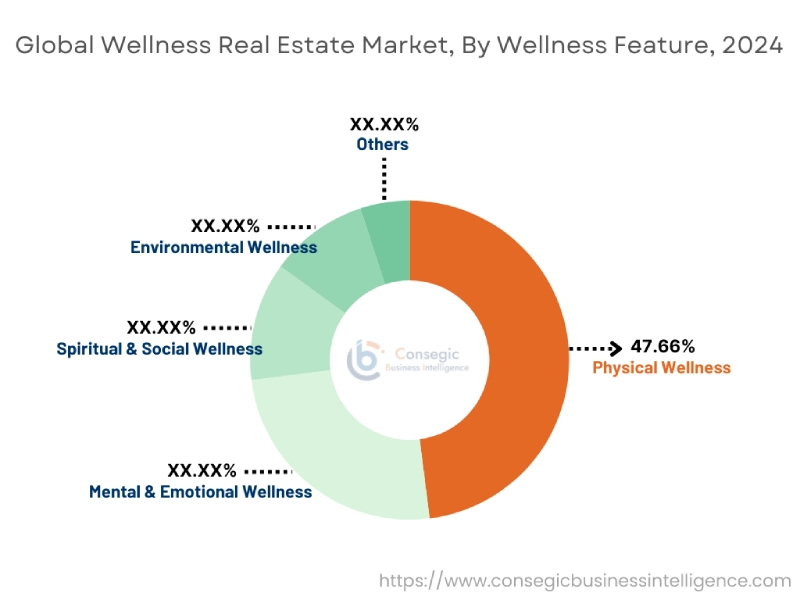
By Property Type:
Based on the property type, the market is segmented into residential and commercial.
Trends in the property type:
- Factors including rising disposable income and increasing development of residential properties with improved ventilation, greener spaces, and fitness centers are key trends driving the residential segment.
- Increasing trend in adoption of modern amenities and wellness programs in commercial spaces that support overall employee/occupant health and wellbeing is driving the commercial segment.
Residential segment accounted for a significant revenue share in the overall wellness real estate market share in 2024.
- Residential wellness real estate primarily includes homes, apartments, and communities that are specifically designed and built to optimize residents’ health and well-being.
- This includes both single-family and multifamily dwellings, as well as planned communities.
- Moreover, the primary features of residential wellness estates include improved indoor air and water quality, presence of fitness/wellness centers, along with access to green spaces and areas promoting social connections, among others.
- For instance, Godrej Properties offers a range of residential properties in India, such as Godrej Nest – Noida, Godrej Green Cove, Pune, and others, which incorporate a fitness center, swimming pool, and other amenities that focus on facilitating the physical wellness of residents within the properties.
- Thus, according to the analysis, the rising development of residential properties with modern amenities that support the overall health and wellness of residents is further propelling the market growth.
Commercial segment is anticipated to register a substantial CAGR growth during the forecast period.
- Commercial wellness real estate mainly includes office buildings, hospitality (hotels & resorts), mixed-use developments, leisure centers, and other commercial properties that integrate wellness principles for supporting occupants’ physical, mental, and social wellbeing.
- This includes buildings with improved air quality, hotels/resorts with wellness programs such as spa, fitness center, and meditation/yoga rooms, or office spaces with amenities that support employee health and wellbeing.
- For instance, in September 2024, the Estate, a new wellness hotel brand, was launched, with the aim of combining hospitality with the latest approaches to wellness, while focusing on analysis of personal health to improve longevity and individual wellbeing.
- Therefore, the increasing developments related to commercial properties focusing on occupant’s health and wellbeing are projected to drive the market growth during the forecast period.
Regional Analysis:
The regions covered are North America, Europe, Asia Pacific, the Middle East and Africa, and Latin America.
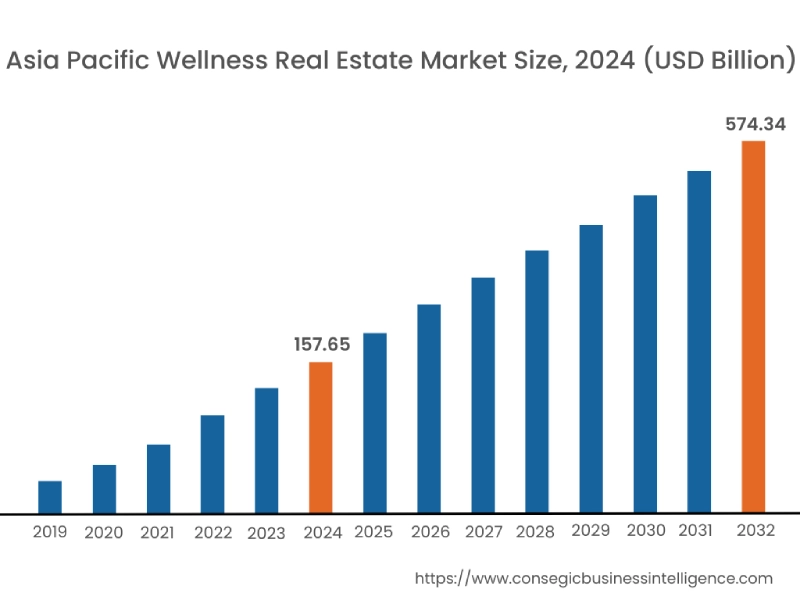
Asia Pacific region was valued at USD 157.65 Billion in 2024. Moreover, it is projected to grow by USD 182.01 Billion in 2025 and reach over USD 574.34 Billion by 2032. Out of this, China accounted for the maximum revenue share of 38.42%. As per the wellness real estate market analysis, the development wellness real estate industry in the Asia-Pacific region is primarily driven by the growing pace of urbanization and rising residential and commercial construction activities. Additionally, the rising consumer awareness regarding physical, mental, and social well-being, combined with increasing demand for residential properties that focus on holistic well-being and sustainable living, is further accelerating the wellness real estate market expansion.
- For instance, according to the Ministry of Trade and Industry of Singapore, the total construction contracts awarded in Singapore in 2022 were valued at USD 9.2 billion for residential construction and USD 1.6 billion for commercial construction. The above factors are propelling the market in the Asia-Pacific region.
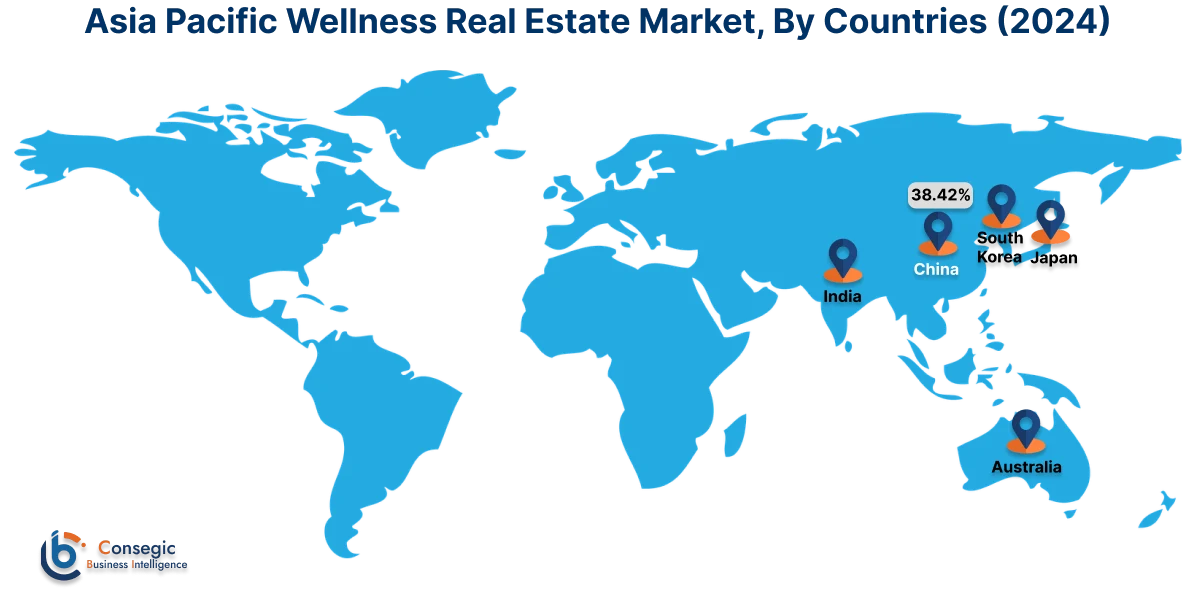
North America is estimated to reach over USD 748.91 Billion by 2032 from a value of USD 216.14 Billion in 2024 and is projected to grow by USD 248.49 Billion in 2025. In North America, the growth of the wellness real estate industry is driven by rising investments in residential and commercial construction, including offices, hotels & resorts, and mixed-use developments, among others. Similarly, the rising consumer preference for properties with sustainable development, greener spaces, and modern amenities such as fitness centers, swimming pools, sports courts, and others is further contributing to the wellness real estate market demand.
- For instance, in April 2022, Delos Living LLC, a U.S.-based company, launched the WISE (Wellness Innovation in Senior Environments) initiative, which combines the company’s expertise in healthy buildings with insights from leaders in the senior living sector to further facilitate a healthier environment for residents and staff and improve overall wellbeing. The above factors are projected to drive the wellness real estate market trends in North America during the forecast period.
In addition, the regional analysis depicts that the increasing awareness regarding physical and mental/emotional health, rising focus on sustainable living, along with growing investments in the development of residential and commercial properties prioritizing improved occupant health and wellbeing, are driving the wellness real estate market demand in Europe. Furthermore, as per the market analysis, the market demand in Latin America, Middle East, and African regions is expected to grow at a considerable rate due to factors such as rising urbanization, increasing construction activities, and growing integration of modern amenities such as fitness centers, swimming pools, meditation rooms, and others within residential, commercial, and mixed-use properties.
Top Key Players and Market Share Insights:
The global wellness real estate market is highly competitive with major players providing solutions to the national and international markets. Key players are adopting several strategies in research and development (R&D), product innovation, and end-user launches to hold a strong position in the global wellness real estate market. Key players in the wellness real estate industry include-
- Berkeley Group (United Kingdom)
- GOCO Hospitality (Thailand)
- CBRE Group Inc. (U.S)
- DPZ CoDesign LLC (U.S)
- Humaniti Montreal Inc. (Canada)
- Godrej Properties (India)
- Skanska Inc. (Sweden)
- Delos Living LLC (U.S)
- Oberoi Realty Limited (India)
- Heta Architects (United Kingdom)
- Sansiri Public Co. Ltd. (Thailand)
- Gamuda Berhad (Malaysia)
Recent Industry Developments :
Business Deal/Agreement:
- In December 2024, Avas Wellness attained a significant milestone with its latest transaction, which was facilitated by the Sotheby’s Realty. This deal, valued at approximately USD 3.07 million, involves the acquisition of a 5-bedroom villa spread across 6,000 square feet at Avas Living in Alibaug, India, by a prominent buyer. Moreover, Avas Living redefines luxury living by seamlessly integrating sustainability, wellness, and elegant design into its properties. This transaction highlights the rising consumer preference for lifestyle-driven investments among buyers who are seeking holistic living solutions.
Wellness Real Estate Market Report Insights :
| Report Attributes | Report Details |
| Study Timeline | 2019-2032 |
| Market Size in 2032 | USD 1,770.48 Billion |
| CAGR (2025-2032) | 19.1% |
| By Wellness Feature |
|
| By Property Type |
|
| By Region |
|
| Key Players |
|
| North America | U.S. Canada Mexico |
| Europe | U.K. Germany France Spain Italy Russia Benelux Rest of Europe |
| APAC | China South Korea Japan India Australia ASEAN Rest of Asia-Pacific |
| Middle East and Africa | GCC Turkey South Africa Rest of MEA |
| LATAM | Brazil Argentina Chile Rest of LATAM |
| Report Coverage |
|
Key Questions Answered in the Report
How big is the wellness real estate market? +
The wellness real estate market was valued at USD 501.70 Billion in 2024 and is projected to grow to USD 1,770.48 Billion by 2032.
Which is the fastest-growing region in the wellness real estate market? +
Asia-Pacific is the region experiencing the most rapid growth in the wellness real estate market.
What specific segmentation details are covered in the wellness real estate report? +
The wellness real estate report includes specific segmentation details for wellness feature, property type, and region.
Who are the major players in the wellness real estate market? +
The key participants in the wellness real estate market are Berkeley Group (United Kingdom), Skanska Inc. (Sweden), Delos Living LLC (U.S), Oberoi Realty Limited (India), Heta Architects (United Kingdom), Sansiri Public Co. Ltd. (Thailand), Gamuda Berhad (Malaysia), GOCO Hospitality (Thailand), CBRE Group Inc. (U.S), DPZ CoDesign LLC (U.S), Humaniti Montreal Inc. (Canada), Godrej Properties (India), and others.
